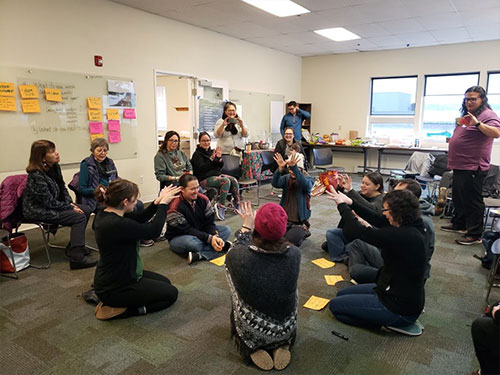
Cultural Integration – Native Language Gathering in KetchikanBy Lisa X’unyéil Worl
February 10, 2020
Alaska schools have been working to close the achievement gap in a variety of ways from boards setting strategic goals around professional development including staff training on how Adverse Childhood Experiences (ACEs) impacts student learning. The School Climate and Connectedness Survey (SCCS) includes questions asking staff, student and families about safety, not so much in the physical sense but in relation to cultural safety.
Our school staff and teachers recognize that our students are coming into the classrooms needing support given some of the intergenerational trauma many Alaskan Native families experienced. As we presented cultural integration sessions at the statewide Safety and Well-being Conference as well as at our Association of Alaska School Board conference, our Alaska Native teachers and staff have been sure to remind others that while trauma is present so is cultural strength. They rightly have pointed out that the Alaska Native culture is an asset that can be used as we teach our students. Culture is a resiliency factor and as noted in the Transforming Schools: A Framework for Trauma-Engaged Practice in Alaska chapter on Cultural Integration and Community Co-Creation “Working in ways that integrate content, ways of learning and students’ cultures can ensure students can build new knowledge sets and achieve high-order thinking more quickly.” Stated simply by our Lingít and X?aad Kíl speakers during our gathering – Tlingit, Haida, Tsimshian culture, which includes language, is healing. In their conversations they shared that “Nothing is more valuable than our languages and that needs to be a core value of our organizations.”, “Our languages are healing us as we learn and speak” and “Being multi-lingual improves brain development.” The language teachers noted some of the challenges too such as:
Then teachers in turn offered these words of encouragement to each other and as reminder in their work with the language learners, both young students and adults:
As we prepared for this gathering, we’d reached out to the Language teachers to see what they wanted. They’d requested time to share resources and lessons with one another. Lower Kuskokwim School District (LKSD) staff, Atan’ Veronica Winkleman and Andrea Engbretson, shared some of LKSD’s experience and resources around creating bilingual schools within their district which allowed the teachers to ask some specific questions around developing scope and sequence curriculum in particular around integrating culture, history, and values within the content. Given the energy of the teachers, clearly the highlights were each of the times they were able to share their language activities and resources with one another. Several of the Lanugage teachers had come prepared to share an activity. Some of the activities included learning through song for early learners, a card game, and one game which involved the students drawing what they heard and switching partners. Lots of laughter could be heard during each of these activities and they provided lots of thinking and opportunity for how they might bring these lessons to their own classrooms. Before the gathering concluded, the teachers scheduled time and suggestions for future gatherings which included:
This gathering was just the first of more for our language speakers. They’ve scheduled a couple more for both large and smaller group work sessions. Gunalchéesh, Háw’aa, N?doyackshn, Thank you to all the Lingít and X?aad Kíl teachers who generously shared their time, energy and knowledge with one another throughout the gathering. To close, I wanted to share in their own words some reflections from our Lingít and X?aad Kíl speakers: X?’unei Lance Twitchell: When we live with our languages, we create spaces for the voices of our ancestors, and we ensure that we are fulfilling our responsibilities by passing gifts of knowing to future generations. There is nothing else that can make this happen. An elder once told us: Gunalchéesh, X?’unei. Naakil.aan Hans Chester: “Gathering with other language warriors and educators gives us a shot in the arm“ as my teacher Florence Marks Sheakley says. In my own being, it helps ease the burden of the work we are all doing-we each carry the weight of this work but by coming together that weight almost ceases to exist. Gunalchéesh, Naakil.aan Hans Chester K’uyáang Ben Young: Our gathering was resourceful and enriching. I loved hearing about the strategies that other early learning programs use to keep their children meaningfully engaged and traditionally grounded. I absorbed many ideas that I’d like to implement at Hydaburg’s program. That meeting was a critical affirmation that we are all in the same canoe. Lgeik’I Heather Powell: What an amazing opportunity to recharge our souls with both fresh ideas, and shared knowledge but also friendship and family. The life of language teaching, learning and living is so imbedded within our lives it’s hard to not be working in the language. And truthfully, that’s what we strive for. Language at home, language at work, language in the store, language everywhere. After our last week spent together, laughing learning and sharpening our tools- I feel inspired as well as lifted both mentally and emotionally. Although the work ahead will be challenging, working with our family from other languages also inspires us to strive forward. I look forward for more opportunities to strengthen our relationship within our language family.
|
|||||
